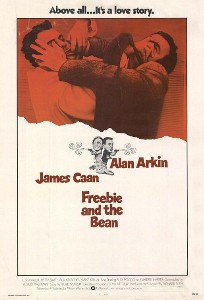Development
The film was based on an original script by Floyd Mutrux, who originally intended to produce his own property. In April 1972, he sold it to Warner Bros. [5]
Mutrux maintained he had gotten offers from other studios but elected to go to Warners because he felt studio vice president Richard Zanuck was "the straightest shooter I've ever known." [6]
The comedy followed on the heels of two popular action films about the San Francisco Police, Bullitt (1968) and Dirty Harry (1971), and incorporates plot elements prominent in both. James Caan later called the film "sort of The Odd Couple in a squad car, detectives, hopefully funny." [7]
Mutrux claims Al Pacino was offered one of the leads but his agent requested $250,000 plus a percentage of the profits, so Warners went with James Caan. This casting happened in June. [6] By August, Richard Rush was attached to direct. [8]
Rush described the original script as about:
Two corrupt cops who ride around in a police car, quarreling with each other like an old married couple. You were never sure which one was the wife and which one was the husband. They became interchangeable. There was also the somewhat clumsy, rough skeleton of the plot concerning a criminal that they must keep alive to testify while assassins are contracted to kill him, which survived through our final film screenplay. I liked these ideas but there was nothing else there to make a movie work. [9]
Rush says John Calley, head of Warners, told the director he could turn it into a "Dick Rush picture...He was very generous and promised the studio would be very agreeable. It was the kind of offer that you can't refuse." [9]
Mutrux left the project and Rush rewrote the script with Robert Kaufman. The director says "we wrote a new screenplay about two bickering cops that became a prototype of the buddy cop movie. I put a lot of meat on the bones, with the unstereotypical wife of Freebie tormenting him with jealousy and the comic relief of their relationship." [9]
In October, Alan Arkin signed to costar with Caan. [10] Rush says Calley, who had worked with Arkin on Catch-22, warned the director that Arkin was "a director killer", but Rush insisted. [9]
Before filming, Rush worked on the script with the two stars and Kaufman in several improvisational sessions. Rush says "at my suggestion they turned what had originally been serious drama into bizarre comedy. Slowly their relationship took on the pains and pleasures of a friendship neither could live with or without." [11]
Arkin admits that it was Rush's idea to turn the film into a comedy. "I hadn't thought about it. I didn't see it in the script." [11]
Shooting
Filming took 11 weeks in 1973. It was a difficult shoot, in part because Arkin and Caan felt their characters were being made secondary to stunts and action sequences. [11]
Arkin said his relationship with Caan "was great. There is a very exciting interaction between us. Jimmy pushes me and forces me to change...But a lot of the time we've taken a back seat to the action." [11]
There were difficulties between Rush and Arkin. Rush says: "I had never had trouble with actors in my life before that film and I have never had problems since. The main factor was Arkin...When I told John Calley I wanted Arkin for the role he warned me Arkin is a director killer. We just did Catch-22 with him and he put Mike Nichols in the hospital. I said Hell, I've never had any troubles with actors. I'll take my chances. It was kind of a stupid mistake on my part. Arkin needed conflict as part of his method, and it was horribly disruptive, but it didn't show in his work. I found myself having to erase my own laughter from the soundtrack because the work Arkin and Caan were doing was so funny.." [9]
Key scenes were shot on location in San Francisco at Candlestick Park. Dealing with local authorities reportedly was difficult for the crew. [11]
The plot includes the protagonists’ repeated "totaling" of a series of their own unmarked police vehicles during three different chase-crash sequences. One sequence was filmed on an elevated portion of the since-demolished Embarcadero Freeway, ending with their police vehicle car crashing into an apartment building. After the car lands in an elderly couple's bedroom as they are watching television, Arkin's character collapses from nervous shock against the wall as Caan's character calls for a tow truck, adding that their location is “on the third floor”. The couple retains their aplomb throughout. [12]
Rush said he "shot the film partly in a Tom and Jerry style, with lots of car chases and car crashes, and the heroes are being indestructible. The audience is laughing and enjoying themselves and suddenly Freebie would drive around the corner into a marching band of kids, and just sloughed through them. The audience thought Wait a minute. What am I laughing at?, and the style of the film had changed to stark realism. There was a lot of game-playing in the picture." [9]
"I never actually knew what Rush wanted," said Arkin at the end of filming. "He [Rush] is so uncertain it's hard to handle," said Caan. [11]
- Paul Rowlands: "Do you think there's an element of repressed homosexuality at all in the relationship between Freebie and Bean?" [9]
- Richard Rush: "Of course." [9]
